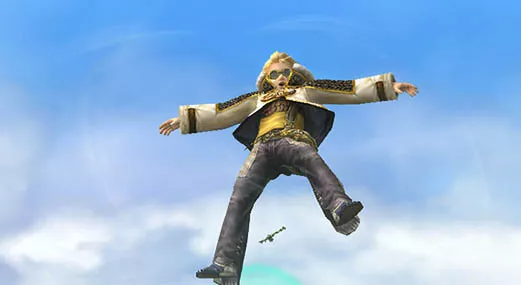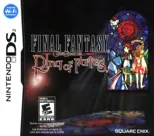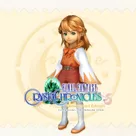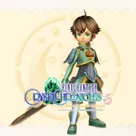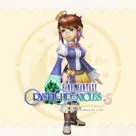Final Fantasy: Crystal Chronicles - The Crystal Bearers
Description official descriptions
Set in the Final Fantasy: Crystal Chronicles universe, in a time when the Lilty Tribe is dominant and the Yuke Tribe doesn't exist anymore, the game tells the Story of Layle, one of the few Crystal Bearers. As opposed to normal people, Crystal Bearers can use magic. This causes them to be considered dangerous. The game begins with Layle and his friend Keiss on a mission as Mercenaries hired by the Lilty Kingdom.
The gameplay makes full use of the Crystal Bearer's abilities using the Wiimote. The player can grab objects, people and enemies using Layle's telekinetic ability, and hurl them around. This is used in battle to damage enemies by throwing them at each others, holding them to use the enemies' abilities or throw stuff at them. Objects such as newspapers and various notes can also be collected using telekinesis. The game features many mini-games and a medal collection, which shows achievements from battles, mini-games, and general exploration.
Two-players Co-op is available in certain mini-games.
Spellings
- ファイナルファンタジー・クリスタルクロニクル クリスタルベアラー - Japanese spelling
Groups +
Promos
Credits (Wii version)
301 People (293 developers, 8 thanks) · View all
| Director | |
| Story and Script | |
| Main Character Designer | |
| Battle Planners | |
| Field Planners | |
| Event Planners |
|
| Special Stages Planners | |
| Programmers | |
| Character Artists | |
| [ full credits ] | |
Reviews
Critics
Average score: 63% (based on 47 ratings)
Players
Average score: 3.4 out of 5 (based on 10 ratings with 1 reviews)
Is Playing This Game Like A Bad Crystal Habit?
The Good
"In the beginning there were the Four Crystals, and together they formed one Principle. Thus the world was created. The Four Crystals next created humanity in their own image, and presided over their destinies. Thus the Four Tribes were born: Lilty, Clavat, Selkie and we Yuke."
—Amidatelion
We control Layle, a young all-American type teenager with telekinesis powers provided to him by crystal power. What is crystal power? It’s something that crystal bearers (which there are several of in the game) have within them. It is an innate power that varies from character to character – some can shoot fire, some can crystallize people and objects and so on. Layle’s power is quite modest, and by the end of the game we will surely have mastered his limited move set (if the Wii control allows that). The action is real-time, so the ‘Final Fantasy’ of the title is at best a misleading, at worst a grab at an established name. I suppose the subtitle and sub-subtitle are the qualifiers here, and are surely intended to make a clear distinction from the main series (although why the ‘Final Fantasy’ lettering outweighs the others is not hard to ascertain).
This title has more in common with Zelda: Twilight Princess than any Final Fantasy title this player has experienced, and although on the surface it may seem like a cheaper, less sophisticated homage, it is soon apparent that the game adds its own flavours and ideas - for better or worse. Although the cut-scenes use the in-game graphical engine (with an applied filter I’m guessing) and seem a little underwhelming, it is the in-game graphics that are the true peak of the artistic merit in this game. Throughout the kingdom we visit many varied, colourful, imaginative and memorable areas. I call them areas because they rarely span beyond the visible horizon, but they are remarkable nonetheless. This is the second game that I have deliberately stopped to admire the scenery more than once (the other title being ‘Okami’), and it is no accident that the developers included an in-game screenshot tool. I’m yet to import then into a PC, but I must add that these ‘shots look strangely blurred (over compressed?) when viewed in the Photo Channel.
Control of Layle is usually from a third-person view, and we are given a tactile pointer with the on-screen Wii pointer – it exists not as a dot or crosshairs, but a constantly swirling, cloudy blue crystal-coloured reticule. Rolling it over an enemy will provide a convenient (but ugly) white outline of the 3D beast, and this means that this particular object is targeted. There is no ‘lock-on’, but the simplistic combat hardly requires it, for Layle makes use of his telekinesis in the simplest terms; he targets items and creatures then with a flick of the wrist he can toss, pull or lift them. That’s about all he is capable throughout the entire playable game. Cut-scenes however, are a different story. In these Layle has powers that are much more interesting, powerful and impressive. It’s almost as if these scenes feature a different character altogether - and it is an odd feeling to be jealous of the same character you’re controlling! As to why Layle has this duality is probably a technical oversight – did the developers run out of time, and only managed to code one main attack method? It seems the likely explanation.
Aside from Layle’s lack of flexibility in his attacks, the single method that he does have is pretty satisfying to use. Battles are all set-pieces in that groups of monsters appear in designated areas all at once, signified by an ominous and sudden audible countdown. There’s no free roaming baddies whatsoever, and if you want to ‘grind’ your character for Gil (currency) or items (used for forging accessories) you’ll need to find one of these areas and complete it within a given time limit. There may be ten or fifteen goons to dispatch and they’re sometimes spread out across a pretty large area. Luckily, the only navigational tool the game provides (a small, onscreen radar) is useful for tracking down the straggling foes. The game offers variation in how you defeat enemies by allowing Layle to pick up various items strewn about the battlefield and launching them at enemies. What will a jar of water do to a half-man/half-cactus creature, what will a jar of oil do to a floating, flaming eyeball, and so on? After any of these clumsy battles, it’s then a matter of closing the game’s portals called ‘miasma streams’, which are long, thin vertically aligned mini tornado-type deals. Yes, the game is pretty odd.
Adventuring across all the brilliantly rendered and designed areas is really good fun. Investigating different routes (where possible) is something that I always enjoy anyway, but when the game looks as good as this it is an even greater pleasure. It must be said that the adventure itself is really quite linear, but there are no time constraints placed on the player, and it’s not possible to miss anything due to any amount of time-wasting you care to do. For those used to Zelda or Okami adventures, you may find the world a little too barren in that there is not a lot to interact with, not much to collect or find or revisit, but it’s enjoyable while it lasts. Primarily, Layle collects Gil or Items and little else – so you’ll be kicking treasure chests open every minute or so, or hurling them in long arcs when they stubbornly refuse to open. One side affect of exploration that may get under players’ skin is that of the interminable plodding of Layle’s footsteps – ticking in the mind like something from Poe’s ‘Tell Tale Heart’. Mixed so loud in the game’s audio hierarchy, the sledgehammer blows of Layle’s steps are even louder than Ray’s in ‘Disaster: Day of Crisis’ – and it wouldn’t be hard to hear him coming from the other side of the capital city (a place that you’ll become very, very familiar with).
This game continues the tradition of Final Fantasy’s high standard of musical material – the soundtrack in this game is excellently composed and memorable. There have been criticisms that the musical styles do not suit the in-game content (for example, battle music that kicks in some of the areas resembles country n’ western rodeo music. As strange as this is at first, the rollicking, slapstick mood it provides is something to remember). Other areas such as the intricately detailed coastal area, encrusted with brightly-coloured shells and corals, are accompanied by a Caribbean style steel drum motif that gives Layle’s costume change of shorts and flip-flops a real beach holiday feel that even the most weathered of city-dwellers can’t help but feel envious of. On the whole, the soundtrack gives each area an identity that is both complimentary and listenable.
The Bad
Voice-acting is another matter altogether. While most of the supplementary cast are suitable enough, Layle and his quasi-companion Belle provide throwaway performances that actually bring the game’s appeal down. Layle sounds like he belongs on a teen-drama, voicing the captain of the football team with his delivery of dialogue rivalling the most dunderheaded of jock characters. His phrasing is flat and mistimed, and I’m convinced his recording is what is called a ‘scratch-track’, (used for basic placement of words and phrases, later to be replaced by a more emotive and nuanced performance). Belle sounds like the character that we’ve all been forced to tolerate in countless comedies and many games: the bubbly, cheerful and immature Valley Girl – only interested in the most trivial matters, while being upheld and rescued by all of those around her, all without any recognition or thanks. I’m not sure why she was even included in the game – she provides nothing to the advancement of the story that I can remember, and serves as a comedic relief that misses the mark with persistent reliability. Keiss, (Layle’s intermittent partner) is voiced well enough, but more importantly it is his temperament and character that keeps the plot from flailing on the floor like a wing-clipped Chocobo. If there’s a sequel to this game or story, Keiss could easily usurp Layle’s moody, inconsistent presence quite well.
For those looking for a simplified Final Fantasy experience, I can think of no better alternative. Fans of Zelda may find something here also, but do not expect tricky problem solving or multi-levelled, hostile dungeons. Layle’s problem solving skills are not yet up to Link’s (although his ‘hookshot’ skills seem to be). Layle cannot level up all that much either, with his base stats being reliant on the equipping of up to three accessory items. Each bit of equipment needs to be fused together with items that can be laughably easy or mind-shatteringly difficult to obtain.
The Bottom Line
Colourful, bright, surprising and simple are the main gifts this game provides; while getting lost, getting confused and cringing at voice-work are some of the lumps of coal it heaps onto your lap. This player though, admits that after completing the entire game for the first time, held no hesitations in restarting the quest from the beginning. The feeling was that there were still areas, items and ‘reactions’ (battle achievements) to uncover. As well as some stray miasma streams to seal up. I’m sure they’re out there somewhere, but can I get past those detracting elements mentioned above to bother finding them? We’ll have to see...
Wii · by So Hai (261) · 2010
Analytics
Upgrade to MobyPro to view research rankings!
Related Sites +
-
Wikipedia: Final Fantasy: Crystal Chronicles - The Crystal Bearers
article in the open encyclopedia about the game
Identifiers +
Contribute
Are you familiar with this game? Help document and preserve this entry in video game history! If your contribution is approved, you will earn points and be credited as a contributor.
Contributors to this Entry
Game added by Fred VT.
Additional contributors: Rik Hideto.
Game added March 14, 2010. Last modified February 22, 2023.

